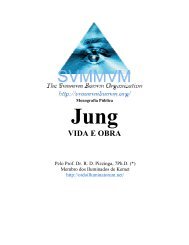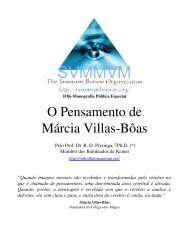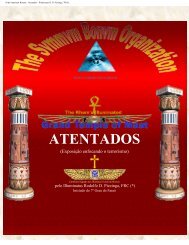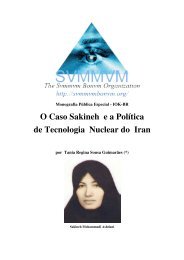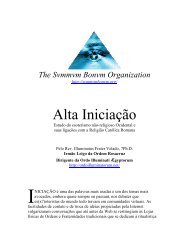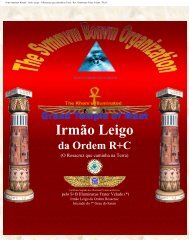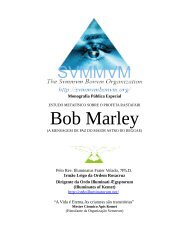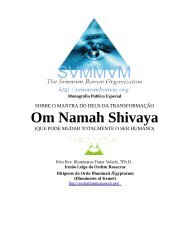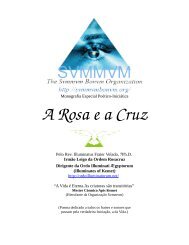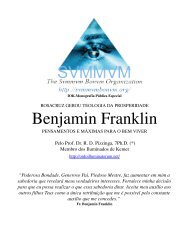History Of The Rose-Croix Sedir - Ordo Svmmvm Bonvm
History Of The Rose-Croix Sedir - Ordo Svmmvm Bonvm
History Of The Rose-Croix Sedir - Ordo Svmmvm Bonvm
Create successful ePaper yourself
Turn your PDF publications into a flip-book with our unique Google optimized e-Paper software.
allowed after three months of training and if they did many operations. <strong>The</strong>y are held to lend<br />
oath. <strong>The</strong>y owe with their maitre obedience until death. Work of the Command is only of<br />
alchemy and magic, with particular secrecies for the brothers. <strong>The</strong> Command has two<br />
houses where the members meet, one in Nuremberg, the other in Ancône; but these<br />
places are at present exchanges, there because for a few years the brothers have settled<br />
in the Indies, " in order to be able to live quiet " (1). *** a similar inspiration gave rise to<br />
Coelum reseratum chymicum (52) of J G Toeltius, where it is known as that to become<br />
Rosicrucian brotherhood, it is to know the divine magic. It is not any more Christian<br />
<strong>Rose</strong>ncreutz who founded the Rosicrucian brotherhood, it is Friedrich <strong>Rose</strong>. This character<br />
had been discovered by Pierre Mormius. Already very old in 1620, it lived the border of<br />
Dauphiné. II said itself member of the Rosicrucian brotherhood d' Or that it would have<br />
founded into 1622, composed only of three members, and whose headquarters were in<br />
the Hague. II refused in Mormius, which returned then from Spain, to accept it in this Order;<br />
after long authorities, it took it only as famulus. Mormius brought what it learned in the States<br />
Généraux from the Hague and, as those refused its discoveries, it consigned them, into<br />
1630, in its Arcana. (53) In 1747, Hermann Fictuld (54), who is given like member of the<br />
Company of Lascaris, affirms that the Command of the Rosicrucian brotherhood d' Or<br />
always exists. He gives him like emblème the Golden Fleece, which is the symbol of the<br />
philosopher's stone, and a ritual with multicoloured ribbons, crosses, parchments and signs<br />
*** In the first quarter of XVIIIe century, the Rosicrucian brotherhood used the work of<br />
isolated mystics, such as Jacob Boehme. <strong>The</strong> shoe-maker-theosophist, who is one of the<br />
most powerful geniuses metaphysics of humanity, never claimed to write new things: all that<br />
he says finds in the Writing and at the school of Nature. Also, to include/understand it, should<br />
be carried out the true religion: to imitate and follow Jesus, " the philosopher Pierre spiritual<br />
", in its sufferings and its death, in order to live again with him. Louis-Claude of Saint Martin's<br />
day had been diverted study of the occult sciences and had been engaged in mystical<br />
sciences by Rodolphe Salzmann which had made known to him the work of Boehme<br />
Jacob. <strong>The</strong> " unknown philosopher " made of the " teutonic philosopher " his true Master,<br />
the judge of all his doctrines, the guide of his higher aspirations, like says it Jacques Matter.<br />
He spread the writings of Boehme in several countries of Europe. At the same time two<br />
writers made known Boehme in England: his/her friend Joachim Morsius, rosicrucian, whose<br />
pseudonym was Anastasius Philaretus Cosmopolita; and William Law, author of beautiful<br />
mystical works. Another disciple of Jacob Boehme, Jean George Gichtel, mystic-born,<br />
apostle of the renouncement, had the revelation of the celestial Virgin, Sophia, who<br />
confirmed it in christic poverty and made known to him the mysteries of interior and external<br />
nature. To the same phalange belong two mystical writers, one in Germany, Karl von<br />
Eckhartshausen, the other in Russia, Ivan Lopoukhine. Karl von Eckharts aulic, then critic of<br />
the bookshop, then preserving of the files from the electoral house in Munich. Like says it<br />
Doctor Marc Haven, " it wanted and known to keep away from all the secret societies, more<br />
or less mystical, which flowered at its time, while remaining, more than anybody, active<br />
member of this Community of the Light which it describes in so perfect knowledge of cause<br />
in his works " (2) Très good, its life was only one uninterrupted continuation of acts of charity;<br />
it was stripped to reduce the sufferings of the French prisoners in 1795. It wrote 79 works,<br />
of which most known are: God is the purest love (1784) and the Cloud on the Sanctuary<br />
(1819) (55) (3). Ivan Wladimirovitch Lopoukhine (1756..1816), Secretary of State of the<br />
Russian Empire (1797) then senator, left pIusieurs works on Frankly-Masonry and he is the<br />
author of Memories which were published in 1860. <strong>Of</strong> him we do not know large-thing, if not<br />
that he knew Mrs. de Krüdener and that he succeeds in softening the first persecutions<br />
directed by the government of the Tsar against Doukhobors. Its main work is a work of pure<br />
mystic: Some Features of the interior Church (Moscow 1798) whose Eckhartshausen said: "<br />
a book invaluable and full with wisdom " (4). To these great names let us add those<br />
eminent of Emmanuel Swedenborg, the " prophet of North " (1688-1772) and the large<br />
Polish mystic André Towianski (1795-1878). *** Such were the missionnés last, at least<br />
known of us, whom caused the Rosicrucian brotherhood. <strong>The</strong>n emerges under its term a




